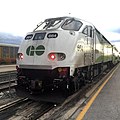| Corridor | Colors | Date | Stations | Length | Track ownership | Note |
|---|
Lakeshore (unified
West and East) | | | 1967-05-23 | 16 | 86.4 kilometres (53.7 mi) | 0 kilometres (0.0 mi) | 0% | Initial service. |
| 1968-04-26 | 15 | Lorne Park station closed. |
| 1968-11-09 | 16 | Exhibition opened. |
| Georgetown | | 1974-04-29 | 22 | 134.4 kilometres (83.5 mi) | New line opened. |
| 1974-12-01 | 23 | Etobicoke North opened. |
| Richmond Hill | | 1978-05-01 | 27 | 168.6 kilometres (104.8 mi) | New line opened. |
| Milton | | 1981-10-26 | 34 | 219.0 kilometres (136.1 mi) | New line opened. |
Bradford
Stouffville | | | 1982-09-07 | 44 | 332.0 kilometres (206.3 mi) | New lines opened. |
| Lakeshore West | | 1988-09-19 | 45 | Appleby opened. |
| Lakeshore East | | 1988-12-04 | 47 | 346.3 kilometres (215.2 mi) | 14.3 kilometres (8.9 mi) | 4.1% | Service extended to Whitby over newly-constructed GO subdivision. |
| Bradford | | 1990-09-17 | 48 | 375.1 kilometres (233.1 mi) | 3.8% | Service extended to Barrie. |
| Georgetown | | 1990-10-29 | 49 | 406.4 kilometres (252.5 mi) | 3.5% | Service extended to Guelph. |
| Lakeshore West | | 1992-05-25 | 50 | Aldershot opened. |
Bradford
Georgetown | | | 1993-07-05 | 48 | 346.3 kilometres (215.2 mi) | 4.1% | Service cut from Barrie and Guelph. |
| Lakeshore East | | 1995-01-09 | 49 | 350.6 kilometres (217.9 mi) | 18.7 kilometres (11.6 mi) | 5.3% | GO subdivision and service extended to Oshawa. |
| Lakeshore West | | 1996-04-29 | 351.6 kilometres (218.5 mi) | Hamilton service shifted to Hamilton GO Centre. |
| Milton | | 1997-03-31 | 23.7 kilometres (14.7 mi) | 6.7% | Galt subdivision purchased from CPR between West Toronto Diamond and Union Station. |
| Bradford | | 1999-04-30 | 33.2 kilometres (20.6 mi) | 9.5% | Newmarket subdivision purchased from CN north of East Gwillimbury. |
| USRC | | 2000-06-07 | 52.1 kilometres (32.4 mi) | 14.8% | Union Station Rail Corridor purchased from Toronto Terminals Railway. |
| Stouffville | | 2001 | 84.2 kilometres (52.3 mi) | 24.0% | Uxbridge subdivision purchased from CN (Scarborough - Uxbridge). |
| Bradford | | 2001-01-07 | 50 | Rutherford opened. |
| 2002-01-16 | 122.0 kilometres (75.8 mi) | 34.7% | Newmarket subdivision purchased from CN between East Gwillimbury and Davenport Diamond. |
| Stouffville | | 2002-09-03 | 51 | Centennial opened. |
| Bradford | | 2002-09-06 | 52 | York University opened. |
| Stouffville | | 2002-12-02 | 53 | Mount Joy opened. |
| Bradford | | 2004-11-01 | 54 | East Gwillimbury opened. |
| Georgetown | | 2005-02-07 | 55 | Mount Pleasant opened. |
| Stouffville | | 2005-06-02 | 56 | Kennedy opened. |
| Milton | | 2007-09-04 | 57 | Lisgar opened. |
| Barrie | | 2007-12-17 | 58 | 380.5 kilometres (236.4 mi) | 150.8 kilometres (93.7 mi) | 39.6% | Service extended to Barrie South, line renamed. |
| Stouffville | | 2008-09-02 | 59 | 383.0 kilometres (238.0 mi) | 153.3 kilometres (95.3 mi) | 40.0% | Service extended to Old Elm (formerly Lincolnville). |
| Georgetown | | 2009-04-08 | 177.8 kilometres (110.5 mi) | 46.4% | Weston subdivision purchased from CN (Bramalea – Union). [10] |
| Barrie | | 2009-12-15 | 193.4 kilometres (120.2 mi) | 50.5% | Remainder of Newmarket subdivision purchased from CN (Davenport Diamond – Union). [11] |
Lakeshore East
Stouffville | | | 2011-03-30 | 234.0 kilometres (145.4 mi) | 61.1% | Kingston subdivision purchased from CN between Union Station and Pickering. [12] |
| Kitchener | | 2011-12-19 | 61 | 437.2 kilometres (271.7 mi) | 53.5% | Service extended to Kitchener. Line renamed. |
| Barrie | | 2012-01-30 | 62 | 442.9 kilometres (275.2 mi) | 239.7 kilometres (148.9 mi) | 54.1% | Allandale Waterfront opened. |
Lakeshore West
Richmond Hill | | | 2012-03-27 | 300.5 kilometres (186.7 mi) | 67.9% | Oakville subdivision purchased from CN between Union Station and Fourth Line; Bala subdivision purchased from CN between Union Station and Doncaster Diamond. [13] |
| Kitchener | | 2013-01-07 | 63 | Acton opened. |
| Lakeshore West | | 2013-03-21 | 313.9 kilometres (195.0 mi) | 70.9% | Oakville subdivision purchased from CN between Fourth Line and Brant Street. [14] |
| Kitchener | | 2014-09-29 | 367.1 kilometres (228.1 mi) | 82.9% | Guelph subdivision purchased from CN between Kitchener and Georgetown. [15] |
| Lakeshore West | | 2015-07-09 | 64 | 446.1 kilometres (277.2 mi) | 82.3% | Service extended to West Harbour. |
| Richmond Hill | | 2016-12-05 | 65 | 453.6 kilometres (281.9 mi) | 80.9% | Service extended to Gormley. |
| Barrie | | 2017-12-30 | 66 | Downsview Park opened. |
| Lakeshore West | | 2019-01-07 | 68 | 522.5 kilometres (324.7 mi) | 70.3% | Service extended to Niagara Falls. |
| Richmond Hill | | 2021-06-28 | 69 | 526.1 kilometres (326.9 mi) | 69.8% | Service extended to Bloomington. |
| Barrie | | 2021-07-19 | 68 | York University station closes. |
| Lakeshore West | | 2025-10-27 | 69 | Confederation station opens. |
| Kitchener | | 2025-11-16 | 70 | Mount Dennis station opens. |










